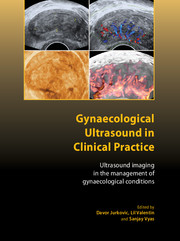 Gynaecological Ultrasound in Clinical Practice
Gynaecological Ultrasound in Clinical Practice Book contents
- Frontmatter
- Contents
- About the authors
- Abbreviations
- Preface
- 1 Ultrasound imaging in gynaecological practice
- 2 Normal pelvic anatomy
- 3 The uterus
- 4 Postmenopausal bleeding: presentation and investigation
- 5 HRT, contraceptives and other drugs affecting the endometrium
- 6 Diagnosis and management of adnexal masses
- 7 Ultrasound assessment of women with pelvic pain
- 8 Ultrasound of non-gynaecological pelvic lesions
- 9 Ultrasound imaging in reproductive medicine
- 10 Ultrasound imaging of the lower urinary tract and uterovaginal prolapse
- 11 Ultrasound and diagnosis of obstetric anal sphincter injuries
- 12 Organisation of the early pregnancy unit
- 13 Sonoembryology: ultrasound examination of early pregnancy
- 14 Diagnosis and management of miscarriage
- 15 Tubal ectopic pregnancy
- 16 Non-tubal ectopic pregnancies
- 17 Ovarian cysts in pregnancy
- Index
11 - Ultrasound and diagnosis of obstetric anal sphincter injuries
Published online by Cambridge University Press: 05 February 2014
- Frontmatter
- Contents
- About the authors
- Abbreviations
- Preface
- 1 Ultrasound imaging in gynaecological practice
- 2 Normal pelvic anatomy
- 3 The uterus
- 4 Postmenopausal bleeding: presentation and investigation
- 5 HRT, contraceptives and other drugs affecting the endometrium
- 6 Diagnosis and management of adnexal masses
- 7 Ultrasound assessment of women with pelvic pain
- 8 Ultrasound of non-gynaecological pelvic lesions
- 9 Ultrasound imaging in reproductive medicine
- 10 Ultrasound imaging of the lower urinary tract and uterovaginal prolapse
- 11 Ultrasound and diagnosis of obstetric anal sphincter injuries
- 12 Organisation of the early pregnancy unit
- 13 Sonoembryology: ultrasound examination of early pregnancy
- 14 Diagnosis and management of miscarriage
- 15 Tubal ectopic pregnancy
- 16 Non-tubal ectopic pregnancies
- 17 Ovarian cysts in pregnancy
- Index
Summary
Introduction
Anal endosonography is a relatively recent development in the evolution of diagnostic ultrasound. Following the original description of the technique by Bartram in 1989, Sultan et al. clarified and validated the interpretation of images. Subsequently, other approaches were described such as transvaginal and transperineal, allowing imaging of the undisturbed anal sphincter. It is now also possible to obtain three-dimensional ultrasound images as well as magnetic resonance images. Anal endosonography is now regarded as the gold standard investigation in patients presenting with faecal incontinence. It is also useful in the diagnosis of anal pain, anorectal tumours, fistulae, abscesses and anismus. The advent of anal endosonography has enabled considerable research into obstetric related anal sphincter trauma, the major aetiological factor in the development of anal incontinence.
Anatomy of the anorectum
Before any attempt is made to image the anal sphincter it is important to have a clear understanding of the anatomy and normal variation of the anorectal musculature to avoid misinterpretation. However, the precise anatomy of the anal sphincter mechanism has remained controversial and there is still disagreement as to whether the external anal sphincter is composed of one, two or three parts. The three-part classification of the external anal sphincter into deep, superficial and subcutaneous components (Figure 11.1) remains the most popular. These subdivisions are difficult to demonstrate during cadaveric dissections, however, and they are certainly not identifiable during surgery.
Keywords
- Type
- Chapter
- Information
- Gynaecological Ultrasound in Clinical PracticeUltrasound Imaging in the Management of Gynaecological Conditions, pp. 121 - 132Publisher: Cambridge University PressPrint publication year: 2009


